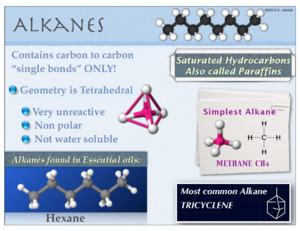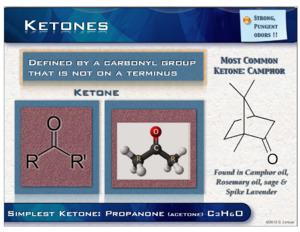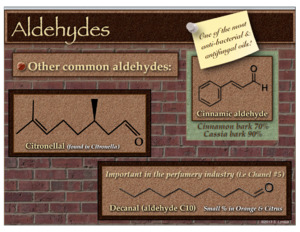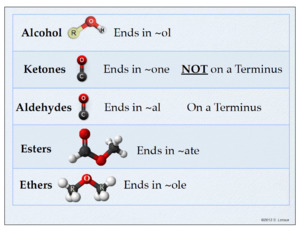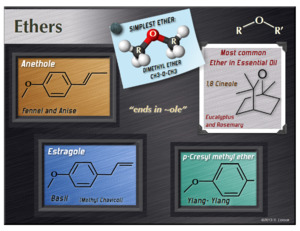Course

The full chemistry of essential oils course comes with a 49 sample chemical kit in a convenient wooden box, course notes in a booklet, video access, quizzes and final test.
No extra book is required or included for this course.
This course is meant for those who have had some chemistry background or else are willing to do some self-study on their own to understand the fundamentals of very basic organic chemistry.
Syllabus
PREREQUISITE: All students must view the seven short videos in the following YouTube playlist: "Basic Organic Chemistry Primer"
| Lecture Text | Course Notes |
| Instructor |
|
If you have not watched the primer videos in the link above then DO NOT TAKE THIS COURSE. There will be no refunds so be sure that you are certain that this course is for you. The course can be started at any time, you only need to finish it within 12 weeks of receiving your kit in order to receive your certificate. Of course you can take as long as you want if you don't care about getting the EOU certificate. Thanks for your interest in the Chemistry of Essential Oils.
Course Content
The Chemistry of Essential Oils (part 1) will be concerned with the relevant chemistry concerning the naturally derived plant oils known as essential oils. Essential oils make up multi billion dollar industry mainly revolving around fragrances and flavors with growing interests in other areas for their medicinal properties.
The chemical constituents, methods of production, as well as uses in the above areas will be discussed. In addition to understanding lecture material students will be required to smell various essential oils and aroma chemicals and be able to identify them based on odor. The course is ideal introduction to anyone pursuing a career in the fragrance, flavor and cosmetic industries as well as for aromatherapy, alternative healing, and massage therapy.
Examinations
There will be one exam graded by Dr. Pappas to determine pass/fail for the course. During the course there will also be 4 quizzes which the student will grade himself after being given access to the video discussion of the keys.
| % | Letter | Description |
|---|---|---|
| 90 - 100% | A | Completion with Highest Distinction |
| 80 - 89% | B | Completion with High Distinction |
| 70 - 79% | C | Completion with Distinction |
| 60 - 69% | D | Completion |
| 0 - 59% | F | No Certificate Given |
Grading
If the student wishes to correlate his percent score on the exam with the grading system we use at Indiana University Southeast the grading scale below can be used for comparison. A score of 60% or better on the exam must be achieve to obtain a certificate of completion. There will be different certificate levels available, ranging from “Completion with High Distinction” to simply “Completion”, corresponding to the 4 levels of passing.
Video Lecture Topics
-
Video Lecture 1 - Introduction Video
- Introduction / Aromahistory - uses of plant aromatics through the ages
-
Video Lecture 2 - Review of Basic Chemistry - Atoms, Molecules and Ions
- Basic chemistry continued
- Bonding patterns of the 3 main elements in EO chemistry
- Systematic naming procedures
-
Video Lecture 3A - Classification by Functional Groups: Hydrocarbons
Video Lecture 3B - Alkanes, Alkenes (Terpenes), Alkynes, Aromatic Hydrocarbons -
Quiz 1 - Quiz 1 Answers: Essential Oil Hydrocarbons
-
Video Lecture 4 - Classification by Functional Groups: Alcohols
- Odor evaluation of essential oil alcohols
-
Quiz 2 - Quiz 2 Answers: Essential Oil Alcohols
-
Video Lecture 5 - Classification by Functional Groups: Aldehydes and Ketones
- Odor evaluation of essential oil Aldehydes and Ketones
- Carrier Oils: Fatty Acid Triglycerides
-
Quiz 3 - Quiz 3 Answers: Essential Oil Aldehydes, Ketones and Carriers
-
Video Lecture 6 - Classification by Functional Groups: Ester and Ethers
- Odor evaluation of essential oil Esters and Ethers
-
Video Lecture 7 - Classification of Functional Groups: Multifunctional compounds
- Odor evaluation of essential oil Multifunctional compounds
-
Quiz 4 - Quiz 4 Answers: Essential Oil Esters, Ethers and Multifunction
-
Video Lecture 8 - The Diversity of Nature - Chirality and Enantiomers
- Quality Control - GC, GC/MS and other analytical methods
- Odor evaluation review – matching up components with oils
-
EXAM 1 –
No video, graded by Dr. Pappas
- Will cover notes and will select only most important samples from each group for odor portion (49 samples would obviously be overwhelming!!)
Booklet
The Chemistry of Essential Oils Booklet is comprised of 44 pages of information concerning the Chemistry of Essential Oils. Whether you have a background in chemistry or not, this booklet will help you to understand the fascinating chemistry of essential oils.
Essential Oils are made up of organic molecules and can further be classified as terpenes, alcohols, esters, aldehydes, ketones, phenols, etc... By understanding the different compound classes, and what oils they appear in, you can determine the expected therapeutic properties of any particular oil.
The booklet comes in a concise 5" x 8" handy format, in full color.
Kit
Kit Contents
- Limonene
- α-pinene
- p-cymene
- β-caryophellene
- Wild Orange oil
- Cypress oil
- Oregano oil
- Linalool
- Geraniol
- Menthol
- Carvacrol
- Coriander oil
- Geranium oil
- Peppermint oil
- Camphor
- Menthone
- L-carvone
- 3-octanone
- Rosemary oil
- Spearmint oil
- Lavender oil
- Citral
- Citronellal
- Cinnamic aldehyde
- Aldehyde C-10
- Lemongrass oil
- Citronella oil
- Cassia oil
- Linalyl acetate
- Bornyl acetate
- Benzyl acetate
- Clary sage oil
- White Fir oil
- Yang Ylang oil
- 1,8 cineole
- Anethole
- Estragole
- p-cresyl methyl ether
- Eucalyptus oil
- Fennel oil
- Basil oil
- Methyl salicylate
- Eugenol
- Vanillin
- Veramoss
- Birch oil
- Clove bud oil
- Vanilla absolute
